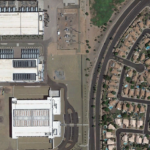#2: This Plant wasn’t a problem the last time we built it
Perhaps that’s true, but a lot of factors can get overlooked if you’re not thinking correctly about noise.
- “This Plant” is actually bigger this time – in general, more megawatts consumed lead to greater noise emission.
- Plants are being located closer to inhabited areas – the same aggregate noise emission results in higher sound levels at the Community.
- Plants are being located near more densely populated areas – for a given percentage annoyed, a greater number of people may strongly object.
- Plants are being located near more wealthy areas – owners of high-value residences usually strenuously object to new, intrusive industrial noise.
- Plants are also being located in rural areas – lower background sound levels (especially at night) and greater expectation of quiet spread annoyance over wider areas.
- Equipment substitutions – higher noise emission per unit and/or more objectionable characteristics are possible particularly when “value engineering”.
- Increased awareness – problems discounted in the past (see Fallacy #1) can lead to vigorous resistance from other Communities in the future.
All of these challenges are foreseeable using well-known noise control principles. The degree of noise impact can be assessed through a pre-installation noise survey and noise emission study. These can and should be completed very early in Project Design while it’s “cheaper” to make changes.
If potential problems are indicated, the Project Developer can then intelligently balance mitigation vs. public welfare. In some cases there may not be an ideal solution, but there’s no good reason to “sleepwalk” into an expensive disaster that may have no practical solution.
Nelson Acoustics can help you anticipate and manage the quantity and characteristics of emitted sound to minimize annoyance. Before it makes the news.
Copyright 2024 Nelson Acoustics
